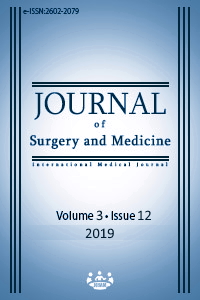Effect of hyperemesis gravidarum on maternal renal health: An investigation of the levels of neutrophil gelatinase-associated lipocalin in maternal serum
Keywords:
Neutrophil gelatinase-associated lipocalin, Hyperemesis gravidarum, DehydrationAbstract
Aim: Hyperemesis gravidarum (HG) is a severe condition that occurs in 0.8–2.0% of pregnant women and can lead to kidney damage. Within minutes of ischemic perfusion injury, renal distal tubular cells release neutrophil gelatinase-associated lipocalin (NGAL). The aim of this study was to assess the levels of NGAL in maternal serum after HG onset and the association between HG severity, renal ischemia, and subsequent kidney damage.
Methods: In this case-control study, the control group comprised healthy volunteers with similar demographic characteristics. The HG patients were divided into three groups according to disease severity based on the Pregnancy-Unique Quantification of Emesis scale as follows: Mild (≤6); moderate (7–12); and severe (≥13). Demographic parameters, biochemical parameters, and serum NGAL levels were compared among the groups.
Results: Serum glucose, serum blood urea nitrogen, serum creatinine, serum phosphorus, aspartate aminotransferase, and alanine aminotransferase levels were similar among the groups. Serum sodium levels were significantly higher in the severe HG group than in all other HG groups. Urine osmolarity was significantly higher in the moderate and severe HG groups than in the control and mild HG groups. There were no differences in serum NGAL levels among the groups.
Conclusion: Our results suggested that serum NGAL levels were not altered in patients complicated by HG.
Downloads
References
Grooten IJ, Mol BW, van der Post JAM, Ris-Stalpers C, Kok M, Bais JMJ, et al. Early nasogastric tube feeding in optimising treatment for hyperemesis gravidarum: the MOTHER randomised controlled trial (maternal and offspring outcomes after treatment of HyperEmesis by refeeding). BMC Pregnancy Childbirth. 2016;16(1):22.
Madendag Y, Sahin E, Madendag Col I, Eraslan SM, Tayyar AT, Ozdemir F, et al. The effect of hyperemesis gravidarum on the 75 g oral glucose tolerance test screening and gestational diabetes mellitus. J Matern Fetal Neonatal Med. 2018;31(15):1989–92.
Practice Bulletin No. 153: Nausea and Vomiting of Pregnancy. Obstet Gynecol. 2015;126(3):e12–e24. https://doi.org/10.1097/AOG.
Koudijs HM, Savitri AI, Browne JL, Amelia D, Baharuddin M, Grobbee DE, et al. Hyperemesis gravidarum and placental dysfunction disorders. BMC Pregnancy Childbirth. 2016;16(1):374.
Mullin PM, Ching C, Schoenberg F, MacGibbon K, Romero R, Goodwin TM, et al. Risk factors, treatments, and outcomes associated with prolonged hyperemesis gravidarum. J Matern Fetal Neonatal Med. 2012;25(6):632–6.
Sahin E, Madendag Y, Eraslan Sahin M, Col Madendag I, Karakukcu C, Acmaz G, et al. Effect of severe hyperemesis gravidarum on maternal vascular endothelial health: evaluation of soluble adhesion molecules. J Matern Fetal Neonatal Med. 2018:1–5.
Sahin E, Madendag Y, Sahin ME, Tayyar AT, Madendag IC, et al. Maternal type 1collagen N-terminal telopeptide levels in severe hyperemesis gravidarum. BMC Pregnancy and Childbirth. 2018;18(1):502.
Kjeldsen L, Bainton DF, Sengelov H, Borregaard N. Identification of neutrophil gelatinase-associated lipocalin as a novel matrix protein of specific granules in human neutrophils. Blood 1994;83:799-807.
Kuwabara T, Mori K, Mukoyama M, Kasahara M, Yokoi H, Saito Y, et al. Urinary neutrophil gelatinase-associated lipocalin levels reflect damage to glomeruli, proximal tubules, and distal nephrons. Kidney Int. 2009;75:285–94.
Mishra J, Ma Q, Prada A, Mitsnefes M, Zahedi K, Yang J, et al. Identification of neutrophil gelatinase-associated lipocalin as a novel early urinary biomarker for ischemic renal injury. J Am Soc Nephrol. 2003;14:2534–43.
Mishra J, Dent C, Tarabishi R, Mitsnefes MM, Ma Q, Kelly C, et al. Neutrophil gelatinase-associated lipocalin (NGAL) as a biomarker for acute renal injury after cardiac surgery. Lancet. 2005;365:1231–8.
Birkeland E, Stokke G, Tangvik RJ, Torkildsen EA, Boateng J, Wollen AL, et al. Norwegian PUQE (pregnancy-unique quantification of Emesis and nausea) identifies patients with hyperemesis gravidarum and poor nutritional intake: a prospective cohort validation study. PLoS One. 2015;10(4):e0119962.
Jo SK, Rosner MH, Okusa MD: Pharmacologic treatment of acute kidney injury: why drugs haven’t worked and what is on the horizon. Clin J Am Soc Nephrol. 2007;2:356–65.
Antonopoulos CN, Kalkanis A, Georgakopoulos G, Sergentanis TN Rigopoulos DN: Neutrophil gelatinase-associated lipocalin in dehydrated patients: a preliminary report. BMC Research Notes. 2011;4:435.
Çelik T, Altekin E, İşgüder R, Kenesari, Y, Duman M, Arslan N. Evaluation of neutrophil gelatinase-associated lipocalin in pediatric patients with acute rotavirus gastroenteritis and dehydration. Italian J Ped. 2013;39(1):52.
Bayoglu Tekin Y, Guvendag Guven ES, Mete Ural U, Yazici ZA, Kirbas A, Kir Sahin F. Evaluation of the effects of fasting associated dehydration on maternal NGAL levels and fetal renal artery Doppler parameters. J Matern Fet Neonatal Med. 2016;29(4):629-32.
Downloads
- 969 1389
Published
Issue
Section
How to Cite
License
Copyright (c) 2019 İlknur Çöl Madendağ, Mefkure Eraslan Şahin, Yusuf Madendağ, Erdem Şahin, Çiğdem Karakükçü
This work is licensed under a Creative Commons Attribution-NonCommercial-NoDerivatives 4.0 International License.
















